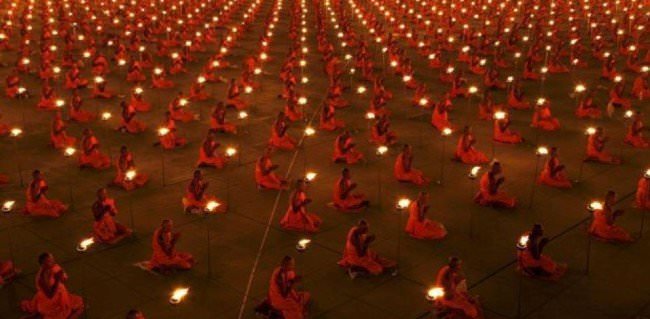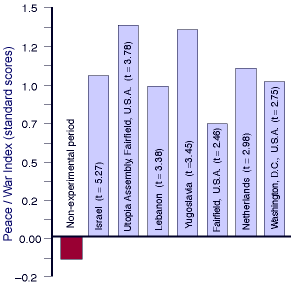Studies done on the Collective Benefit of Group Meditation
Feb 24, 2017 17:58:18 GMT -8
Yoda likes this
Post by WeAreAllOne on Feb 24, 2017 17:58:18 GMT -8

Below is a compilation of all the research and studies I could find in regards to the collective benefit of group meditation, and its affect on the global unconscious. If you have any additional links or research to contribute, please feel free to reply to this thread and I will happily add it to this growing list.
Thank you.
Meditation has the potential to literally transform the world. In 1978, what is known as the “Maharishi Effect” took place when a group of 7000 individuals over the course of 3 weeks were meditating in hopes of positively effecting the surrounding city. They were able to literally transform the collective energy of the city which reduced global crime rates, violence, and casualties during the times of their meditation by an average of 16%. Suicide rates and automobile accidents also were reduced with all variables accounted for. In fact, there was a 72% reduction in terrorist activity during the times at which this group was meditation.
Almost 50 studies have been done further confirming the benefits of global meditation and it’s direct impact on everything in the world, even so far as to have the results published in the Journal of Crime and Justice in 1981. We know meditation has endless health and psychological benefits, but it is now being explored by politics and sociology because of its undeniable energetic impact.





For example, a day-by-day study of a two-month assembly in Israel during August and September of 1983 showed that, on days when the number of participants at a peace-creating assembly was high, the intensity of an ongoing war in neighboring Lebanon decreased sharply. When the number of participants was high, war deaths in Lebanon dropped by 76%.
"For those with a basic layman’s understanding of quantum physics, it may come as no surprise that the simple act of meditation can have quantum results that affect not only the meditator, but his or her surrounding community and the world as a whole.

When the study was repeated in Wales, they got amazing results. In 1987 Merseyside had the third highest crime rate of the eleven largest Metropolitan Areas in England and Wales; by 1992 it had the lowest crime rate. 40% below levels predicted by the previous behaviour of the series. There were 255,000 less crimes in Merseyside from 1988 to 1992 than would have been expected had Merseyside continued to follow the national crime trend.
The secret of the Global Maharishi Effect is the phenomenon known to Physics as the ‘Field Effect’, the effect of coherece and positivity produced from the field of infinite correlation—the self-referral field of least excitation of consciousness—the field of Transcendental Consciousness, which is basic to creation and permeates all life everywhere. Meditation takes your consciousness to the implicate levels of existence where your intentions have consequential effects on the explicate level that we interact with before it even manifests. Consciousness gives rise to the material. The key idea is that all of existence emanates out of a field of universal consciousness, called the Unified Field or Super String Field.
“I think the claim can be plausibly made that the potential impact of this research exceeds that of any other ongoing social or psychological research program. It has survived a broader array of statistical tests than most research in the field of conflict resolution. This work and the theory that informs it deserve the most serious consideration by academics and policy makers alike.”
David Edwards Ph.D., Professor of Government, University of Texas at Austin.
EEG technology has been used for meditation research.
Happiness
A study on Brahma Kumaris Raja yoga meditators showed them having higher happiness (Oxford happiness questionnaire) than the control group.[121]
Positive relationships have been found between the volume of gray matter in the right precuneus area of the brain and both meditation and the subject's subjective happiness score.
Citation 1
Citation 2
Citation 3
Citation 4
Citation 5
Citation 6
Mindfulness practice leads to increases in regional brain gray matter density
The structural neural substrate of subjective happiness
Meditation’s positive residual effects. Imaging finds different forms of meditation may affect brain structure.
A new study has found that participating in an eight-week meditation training program can have measurable effects on how the brain functions even when someone is not actively meditating. In their report in the November issue of Frontiers in Human Neuroscience, investigators at Harvard Medical School-affiliated Massachusetts General Hospital (MGH), Boston University (BU), and several other research centers also found differences in those effects based on the specific type of meditation practiced.

“The two different types of meditation training our study participants completed yielded some differences in the response of the amygdala — a part of the brain known for decades to be important for emotion — to images with emotional content,” says Gaëlle Desbordes, a research fellow at the Athinoula A. Martinos Center for Biomedical Imaging at MGH and at the BU Center for Computational Neuroscience and Neural Technology, corresponding author of the report. “This is the first time that meditation training has been shown to affect emotional processing in the brain outside of a meditative state.”
The study was supported by grants from the National Center for Complementary and Alternative Medicine, including an American Recovery and Reinvestment Act grant to Boston University.
Full article is here, on Harvard's website. Click this to read.
Washington meditation project reverses violent crime trend by 23.3%
An experiment in Washington DC to study the effect of a large group of meditators on social trends, saw a rapid reversal in the violent crime trend during the project period.

The researchers, led by John Hagelin a renowned quantum physicist, set up this major prospective social study. The idea was to show how easy and simple it is to reduce crime and social stress by using meditation to intervene from the field of consciousness.
As with earlier studies, the method for achieving this crime reduction was the deployment of a coherence-creating or Super Radiance group of meditators known as TM-Sidhas. (What is a TM-Sidha?)
About forty earlier studies had already demonstrated the power of the Super Radiance effect to create more coherence in society. So the understanding of coherence creation with groups of meditators was already well established, at least with the research team if not the authorities.
This time, what the researchers aimed to do was make a big impression in the most important capital city of the world. The idea was to attract attention from the relevant authorities as to the immense possibilities for crime fighting and war prevention using group meditation.
Part of the plan was to create a cast iron research protocol that would withstand all critical challenges as to the fairness and thoroughness of the experiment.
The research team included a member from the District of Columbia Metropolitan Police Department
With this in mind, a 27-member Project Review Board was set-up comprising independent scientists and leading citizens. Their task was to ensure objectivity and research rigour by reviewing and approving the research protocol and then subsequently monitoring the research process.
The research team itself was broad based also to ensure against bias. Apart from the scientists from Maharishi Universtity of Management, the team included members from the Center for International Development and Conflict Management, University of Maryland, the Department of Humanities and Social Sciences, University of the District of Columbia, and the Planning and Research Division, District of Columbia Metropolitan Police Department.
These precautions proved worthwhile. Ultimately, the research project was considered sufficiently sound, balanced and thorough enough to be published in the peer reviewed scientific journal 'Social Indicators Research'.
Police ridicule prediction
The project took place between June 7th and July 30th 1993. Based on previous experience, the researchers predicted in advance that the TM-Sidha group would reduce crime by over 20% in the city during the study period. The researchers confirmed that the group would achieve this effect without any verbal, social, political or physical interaction between the meditators and the local community. The positive impact would be made quietly and discreetly from the field of consciousness.
At the time the local police authority ridiculed this prediction. The police chief actually went on record to assert that the only event that would reduce crime that much in Washington during the summer months would be 20 inches of snow. The police were well used to crime rising year on year and also rising during the summer months as the weather got hotter and the days longer.
Undeterred by this professional cynicism, 800 TM-Sidhas arrived in the first week of the trial period. This influx gave the group a comfortable Super Radiance level straight away for the conurbation around Washington. By the last two weeks of the two-month trial period the group had grown to 4,000 in number.

Important departure from the usual √1 % formula
Normally, the Super Radiance threshold for an area is the number of TM-Sidhas it takes to equal or exceed the square root of 1% (√1 %) of the local population, (About 173 TM-Sidhas for Washington DC). However, in this instance it was felt safer to create or exceed the Super Radiance effect for the whole country.
So instead of aiming to attract 173 TM-Sidhas, the study team set out to attract in excess of 1,750 TM-Sidhas, the √1 % of the entire US population.
There were important reasons for this change in the standard Super Radiance formula.
The reasoning was based on Washington DC’s prominence as the national capital of the world’s major super power. The city not only includes national institutions such as the Presidency, the Supreme Court of Justice, Congress and many other government organisations nearby, it also houses the Pentagon, The State Department and the CIA headquarters.
These powerful institutions of state spread their influence right across the world. And on the level of consciousness this influence is entirely reciprocal. Unfortunately for the US it is a case of “As you sow, so shall you reap.”
Washington’s crime rate is three times the national average
As such, the researchers saw the city, as a focal point of collective stress both from the nation and the international community. They surmised that it was this exposure to global collective stress that provoked such a high level of crime within the area - over three times the national average crime level.
In other words, the researchers reckoned that to instigate a rapid decline in local crime, the TM-Sidha group would have to be able to handle a lot more than just the locally generated level of collective stress.
Recent history of climbing crime rates

Washington’s immediate history showed that during the first five months of the year prior to the research project, violent crime had been steadily increasing. This increase continued on into the first two weeks of the project when homicides actually continued to increase.
But after this initial period and as the numbers of the meditating group grew, violent crime began a steep decline (to help standardise the statistical study, the researchers adopted the FBI's Uniform Crime Statistics definition of violent crime or HRA crime: homicides, rapes and aggravated assaults). From then on until the end of the two-month experiment, HRA crime stayed well below the time series prediction for that period of the year.
23.3% drop in HRA crime during the demonstration
The maximum impact was an unprecedented drop in HRA crime of 23.3%. This maximum effect occurred when the size of the group was at its largest in the final phase of the project.
The statistical probability that this result could reflect chance variation in crime levels was less than 2 in 1 billion (p < .000000002).
Soon after the project and as predicted by the researchers, HRA crime began to rise again.
The researchers tested their findings for other possible causes, such as temperature, precipitation, weekends, and police and community anti-crime activities and found that the drop in crime could not be attributed to any of these other possibilities.
Contrary to the Police chief’s predictions, Washington did not benefit from 20 inches of snow. In fact throughout the project the city experienced extremely hot weather conditions. In effect the project broke the regular cycle of rising crime seen during the increasingly hot weather as the summer season wears on in Washington.
Importantly, when the research team analysed the same period in each of the five previous years they found no significant decreases in HRA crimes in those periods. The 1993 results were a one off event.
A range of other improvements
Also, as predicted by the researchers before the project, there was a range of other improvements during the study period.
• President Clinton experienced improved approval ratings (p =5.29 x 10-8).
• Media positivity toward Clinton showed a net change increase (p =.01).
• Emergency psychiatric calls decreased (p =.009).
• Hospital trauma cases decreased (p =.02).
• Complaints against the police decreased (p =.01).
• Accidental deaths decreased (p =.05).
• Quality of life index improved (p =3.22 x 10-5).
Research details
Hagelin JS1; Orme-Johnson DW; Rainforth M1; Cavanaugh K1; Alexander CN1; Shatkin SF1; Davies JL2; Hughs AO3; Ross E4; "Effects of Group Practice of the Transcendental Meditation Program on Preventing Violent Crime in Washington, D.C.: Results of the National Demonstration Project, June--July 1993", D.C.Institute of Science, Technology and Public Policy Technical Report 94:1, 1994. Social Indicators Research (vol 47 issue 2: 153-201, 1999)
Author Affiliations
1. Institute of Science, Technology and Public Policy, Maharishi University of Management, Fairfield, Iowa, USA
2. Center for International Development and Conflict Management, University of Maryland, College Park, Maryland, USA
3. Department of Humanities and Social Sciences, University of the District of Columbia, Washington, D.C., USA
4. Planning and Research Division, District of Columbia Metropolitan Police Department, Crime Research and Statistics Section, Washington, D.C., USA
The full paper can be read in the Collected Papers of the Scientific Research on Maharishi’s Transcendental Meditation and TM-Sidhi Program vol 6 - 489; published by Maharishi European Research University and Maharishi International University.
www.worldpeacegroup.org/washington_crime_prevention_full_article.html
Research Shows Group Meditation Can Reduce Crime Rates.
By Mimi Mudd on April 1, 2014
Along with the mounting medical evidence of the various health benefits of meditation, research shows group meditation can actually reduce crime rates in the greater population. With connections which go beyond explanation by other variables, the results show that city-wide crime rates were reduced by small meditating groups of less than one percent of the population — not by holding community-wide meditation sessions or treating criminals with meditation therapy but by meditating on peace and positivity in small groups.
Known as the Maharishi Effect, the idea is that individual brain waves can affect the collective consciousness. Though the exact science to explain how the brain waves of a small meditating group can effect the actions of the greater population is still not known, nearly 50 studies have been done on the subject and have appeared in prestigious publications such as the Journal of Crime and Justice.

The form of meditation used to produce the Maharishi Effect is called the Transcendental Meditation Sidhi Programme. Those who have practiced this deep state of consciousness describe it as uplifting and say they “experience a state of bliss.” Several compare it to a feeling like they are flying, and in the Vedic literature it is even referred to as Yogic Flying. The Yoga Sutra states that “In the vicinity of coherence (yoga) hostile tendencies are eliminated,” and practitioners of this meditation program believe it creates a “unified field” which transforms stressful, negative, and undesirable tendencies in brain physiology.
Whether science is able to prove their beliefs or not, the positivity and well-being spread by followers of the Maharishi’s meditation technique is certainly not a bad thing for society. As many as 7,000 people have gathered at one time to meditate with the Maharishi in the name of world peace.
Some of the most impressive research into group meditation came from Merseyside, England, which shows group meditation was not only able to reduce crime rates, but can save cities millions of dollars. A time series analysis was used to evaluate reduction in crime. During periods when a meditating group slightly larger than the square root of one percent of the population held sessions the monthly data showed a 13.4 percent drop in crime. This was very significant in contrast to the national crime rate which had actually increased by 45 percent.
Even when considering variables such as police practices and economic changes the research still points to a strong correlation between the group meditation and the drop in crime rates. Merseyside went from No. 3 ranking in highest crime rates among the eleven largest Metropolitan Areas in England and Wales in 1987 to the lowest crime rate by 1992. The Merseyside Home Office estimated the reduction in crime saved around £1250 million over the five-year period.
How does the Maharishi Effect reduce crime? Some researchers have proposed that the meditating group is able to increase coherence and decrease stress in the collective consciousness of a society, thus improving something referred to as “informal social control,” which reduces criminal acts. In a review of various research conducted on city, state, national, and international levels, 15 published studies showed strong evidence that group meditation was able to reduce crime rates, and programs like these can easily be replicated elsewhere.
By Mimi Mudd
guardianlv.com/2014/04/research-shows-group-meditation-can-reduce-crime-rates/







transcendental-meditation.be/category/1-percent-effect/
Compilation of Sources & Links Below:
permanentpeace.org/evidence/war.html
guardianlv.com/2014/04/research-shows-group-meditation-can-reduce-crime-rates/
blog.ted.com/4-scientific-studies-on-how-meditation-can-affect-your-heart-brain-and-creativity/
news.harvard.edu/gazette/story/2012/11/meditations-positive-residual-effects/
en.wikipedia.org/wiki/Transcendental_Meditation
www.ncbi.nlm.nih.gov/pmc/articles/PMC4653620/
www.ncbi.nlm.nih.gov/pmc/articles/PMC3004979/
en.wikipedia.org/wiki/Research_on_meditation
www.care2.com/greenliving/the-power-of-group-meditation.html
www.chopra.com/articles/the-power-of-group-meditation
in5d.com/proof-that-group-meditation-can-change-the-world/
www.worldpeacegroup.org/washington_crime_prevention_full_article.html
www.tandfonline.com/action/cookieAbsent#.UzrltihwiB8
www.tandfonline.com/action/cookieAbsent#.UzrlzShwiB-
www.beliefnet.com/columnists/haveamagnificentday/2016/11/meditation-transforms-world.html
www.evolveandascend.com/2015/12/18/the-maharishi-effect-the-power-of-group-meditation-to-bring-peace/
transcendental-meditation.be/category/1-percent-effect/
www.facebook.com/tmmeditationuk/posts/10153000237187361



